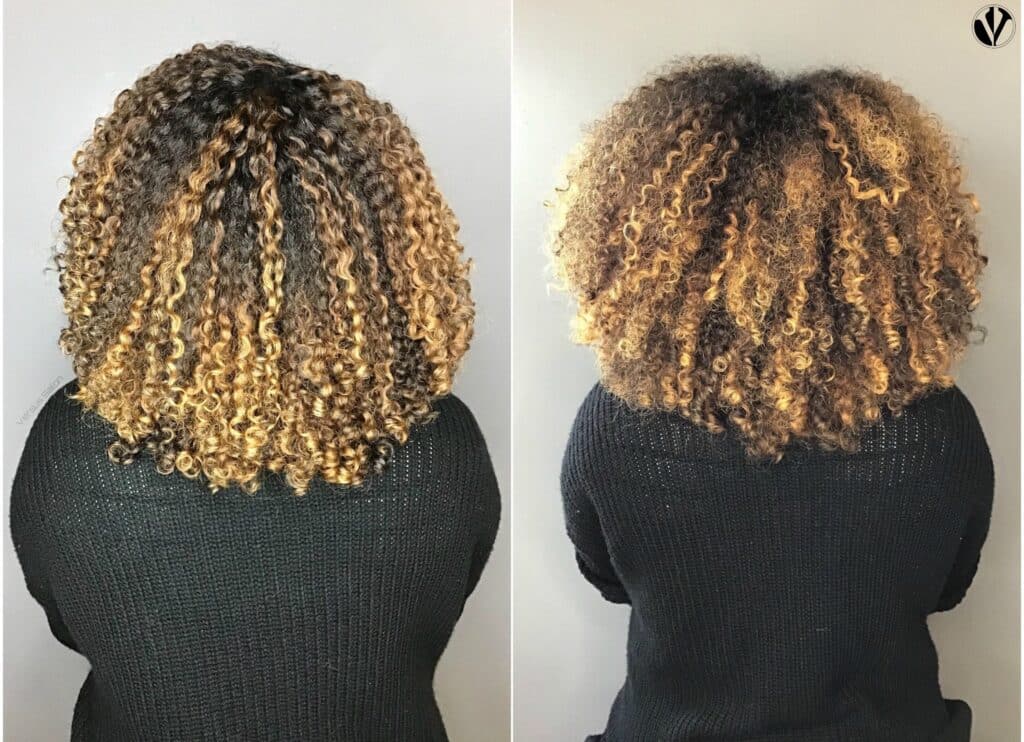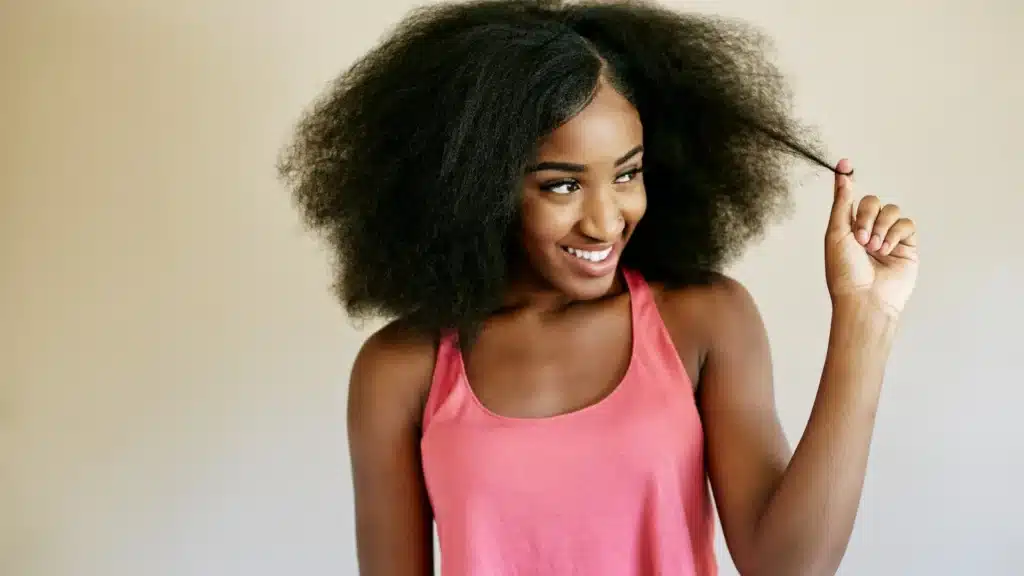Low porosity hair is a term you may have heard if you’ve delved into the world of hair care. In simple terms, it’s all about how your hair absorbs and retains moisture.

Are you one of those folks who struggle to keep their hair moisturized, no matter how many products you’ve tried? If so, you might have low-porosity hair. But don’t worry, you’re not alone, and there’s a simple explanation for what’s going on with your locks.
Think of your hair as a sponge – some sponges soak up water quickly, while others seem to repel it. Low porosity hair is like the latter; it’s not very eager to drink up that much-needed hydration.
But what exactly does “low porosity” mean? Well, porosity refers to your hair’s ability to absorb and retain moisture, oils, and other hair products. When your hair has low porosity, the cuticles, like tiny protective shields on each strand, are tightly packed and less likely to let moisture in.
This can make it a bit challenging to keep your hair well-hydrated, which often leads to issues like dryness, frizz, and difficulty with product absorption.
Low porosity hair can be a genetic trait, so it’s something you might have inherited. But it can also be influenced by your hair care routine and the products you use. Understanding your hair’s porosity is a crucial step in tailoring your hair care routine to meet its specific needs.
Let’s delve deeper into the world of low-porosity hair, exploring how to care for it, the best products to use, and the characteristics of low-porosity hair. So, if you’re tired of struggling with dry, unmanageable hair, keep reading to discover the secrets to managing and loving your low-porosity tresses.
Related: What are Trixie Tongue Tricks? A Comprehensive Guide
Characteristics Of Low Porosity Hair

Low-porosity hair has several distinct characteristics:
1. Slow to Absorb Moisture
Low-porosity hair has difficulty absorbing water, oils, and products. It may take a long time for hair to become wet in the shower.
2. Product Buildup
Because the hair cuticle is tightly closed, it can easily accumulate product buildup, making it prone to looking greasy or weighed down.
3. Resistant to Chemical Treatments
Low-porosity hair can be resistant to chemical treatments like colouring or perming, as the cuticle’s resistance makes it difficult for chemicals to penetrate.
4. Prone to Dryness
While it resists moisture absorption, low-porosity hair can also struggle to retain moisture, leading to dryness and frizz.
5. Slow Drying Time
Hair with low porosity tends to dry slowly, as the tightly closed cuticle hinders water evaporation.
6. Difficulty with Hair Products
It may be challenging to find hair products that work well with low-porosity hair. Lightweight, liquid-based products are usually more effective.
7. Susceptible to Product Residue
Hair products can leave residue more easily on low-porosity hair, so it’s important to use clarifying shampoos periodically.
8. Prone to Heat Damage
Low-porosity hair can be more susceptible to heat damage, so be cautious when using hot styling tools.
Understanding these characteristics is essential for properly caring for and styling low-porosity hair. It often requires using specific products and techniques to maintain healthy and manageable hair.
Related: 10+ Modern Mullet Haircuts for Men and Women (2023)
What Causes Low Hair Porosity?

The natural structure of your hair often causes low hair porosity, and it’s something you can inherit from your parents. Think of it like your hair’s personality. Some people are born with hair that’s more likely to have low porosity, just like some folks inherit blue eyes or curly hair.
So, what’s going on with low-porosity hair? Well, it’s all about the cuticles, those tiny protective shields that cover each strand. In low-porosity hair, these cuticles are tightly packed together. It’s like they’re playing a game of “keep out” with moisture and hair products. This means your hair is a bit picky about what it lets in, and it can be pretty resistant to absorbing water and oils.
Apart from genetics, your hair care routine can also influence its porosity. If you’re a fan of using heat styling tools frequently or have a thing for heavy product buildup, your hair might become even more stubborn about letting things in.
But don’t worry. Understanding what’s behind your low-porosity hair is the first step to giving it the care it craves. With the right tricks and products, you can coax those cuticles to open up and welcome in the moisture your locks need.
Related: 10+ Stunning Wolf Cut Hairstyle for Men and Women in 2023
How Can I Tell If I Have Low Porosity Hair?

Figuring out if you have low porosity hair is like solving a little hair puzzle. Here’s a simple way to do it:
The Float Test
Take a few clean, dry strands of your hair (don’t use hair that’s just been washed) and drop them into a glass of water. Watch what happens:
- If your hair floats on the water’s surface and takes its sweet time to sink, you likely have low porosity hair. It means your hair is pretty good at keeping water out.
- If your hair sinks quickly, your hair might have higher porosity, meaning it drinks up water faster.
Remember, this test isn’t 100% foolproof, but it can give you a good idea about your hair’s porosity. Low-porosity hair tends to be a bit more resistant to soaking up moisture, so it might take some extra love and care to keep it hydrated and healthy.
Related: 30 Gorgeous Curly Hairstyles for Short Hair
The Product Test
- Wash your hair and let it air dry or gently blot it with a towel. Make sure it’s completely clean and product-free.
- Apply a small amount of a water-based leave-in conditioner or hair product to a section of your hair.
- Watch how your hair reacts:
- If the product seems to sit on the surface of your hair without absorbing, and your hair takes a long time to dry, you likely have low porosity hair.
- If the product is quickly absorbed and your hair dries relatively fast, your hair may have higher porosity.
This test is another way to gauge your hair’s porosity and can give you a better idea of how your hair interacts with products. It’s good to consider both the float test and the product test together for a more accurate understanding of your hair’s porosity.
Related: 30 Inspiration Burst Fade Hairstyles for Men 2023
Can Low Porosity Be Cured?

Low porosity hair isn’t something that can be “cured” in the traditional sense because it’s primarily a result of your hair’s natural structure. However, you can manage and improve the condition of low-porosity hair with the right care and attention. Here’s what you can do:
1. Tailored Hair Care Routine
Adjust your hair care routine to suit low-porosity hair. This may involve using specific products and techniques to encourage better moisture absorption.
2. Clarifying
Periodically use a clarifying shampoo to remove product buildup and allow better product penetration.
3. Heat Treatments
Applying heat during deep conditioning or treatments can help open the hair cuticles, allowing moisture to penetrate.
4. Use Lightweight Products
Choose hair products that are lightweight and water-based. Heavy products can weigh down low-porosity hair.
5. Avoid Overuse of Protein
Too much protein in your hair products can make low-porosity hair feel stiff and less receptive to moisture.
6. Regular Trims
Keep your hair ends healthy by getting regular trims to prevent split ends and damage.
7. Patience
Understand that low-porosity hair may take a bit longer to absorb and retain moisture. Consistency and patience are key.
While you can’t change the fundamental porosity of your hair, these tips can help you manage it effectively and keep your low-porosity hair healthy and looking its best.
Related: Step-by-step Skincare Routine To Achieve Glowing Skin
10 Ways To Care For Low Porosity Hair

Caring for low-porosity hair doesn’t have to be complicated. In fact, it’s all about finding the right balance to keep those cuticles happy. Here are 10 simple ways to care for your low-porosity locks:
1. Clarify Your Hair
Start with a clarifying shampoo to remove any product buildup and open up those cuticles. Do this every few weeks to keep things fresh.
2. Use Warm Water
When you wash your hair, use warm water to help the cuticles relax and open up. But don’t go too hot; you don’t want to scald your scalp.
3. Deep Conditioning
Use a good-quality, moisturizing conditioner. Focus on the ends, where your hair needs it most. For extra penetration, apply heat with a shower cap or warm towel.
4. Leave-In Conditioner
After washing, apply a leave-in conditioner to lock in moisture. It’s like a little extra love for your hair.
5. Seal with Oil
Seal in that moisture with lightweight oils like jojoba or argan oil. They’re great for low-porosity hair.
6. Avoid Heavy Products
Stay away from thick, heavy products that can weigh your hair down. Opt for lightweight, water-based products.
7. Detangle Carefully
Be gentle when detangling your hair, using a wide-tooth comb or your fingers. This prevents damage and breakage.
8. Try the L.O.C. Method
This is the Liquid (water), Oil, and Cream method. Apply them in that order to maximize moisture retention.
9. Avoid Excess Heat
Limit the use of heat-styling tools like flat irons and blow dryers. When you do use them, use a heat protectant.
10. Patience is Key
Low-porosity hair can take time to absorb products. Don’t get discouraged if you don’t see instant results. Consistency is key.
Remember, it’s all about understanding and catering to your hair’s unique needs. With a little patience, you can keep your low-porosity hair looking healthy and beautiful.
Related: Textured Fringe Haircut: Meaning, 20+Best Hairstyles to Try
10 Good Products For Low Porosity Hair

Finding the right products for low-porosity hair can be a game-changer in managing and maintaining its health. Here are 10 good products to consider:
1. Clarifying Shampoo
Use a clarifying shampoo occasionally to remove product buildup and open the cuticles. Example: Neutrogena Anti-Residue Shampoo.
2. Co-Wash Cleansing Conditioner
These are gentle cleansers that add moisture. Example: As I Am Coconut CoWash.
3. Leave-In Conditioner
A lightweight, hydrating leave-in conditioner can help keep your hair moisturized. Example: Kinky-Curly Knot Today.
4. Deep Conditioner
Opt for deep conditioners with penetrating ingredients. Example: SheaMoisture Manuka Honey & Mafura Oil Intensive Hydration Masque.
5. Hair Oil
Lightweight oils like argan or jojoba can help lock in moisture without weighing your hair down.
6. Gel or Curl Definer
Use a water-based, alcohol-free gel or curl definer to define your curls without causing buildup. Example: ECO Styler Gel (the one without alcohol).
7. Heat Cap or Hooded Dryer
These can help when deep conditioning by providing gentle heat to open the cuticles.
8. Spray Bottle
Fill it with water and aloe vera juice or aloe vera gel to refresh your hair and add moisture when needed.
9. Protein-Free Products
Check the ingredient lists to avoid products with excessive protein, as too much can make low-porosity hair feel stiff.
10. Scalp Massager
To promote scalp health and stimulate blood circulation, use a scalp massager during shampooing.
Remember, what works best for your low-porosity hair may vary, so it’s important to experiment with different products and techniques to find the combination that suits you the most.
Related: Dahlia Dimples: All you Need to Know
5 Best Hair Oils For Low Porosity (Product + Description)

When it comes to low-porosity hair, it’s essential to choose hair oils that are lightweight and easily absorbed. Here are five of the best hair oils for low-porosity hair, along with a brief description of each:
Jojoba Oil
Description: Jojoba oil is a liquid wax that’s very similar to the natural oils produced by your scalp. It’s incredibly lightweight and non-greasy, making it an excellent choice for low-porosity hair. Jojoba oil helps moisturize and condition your hair without weighing it down.
Argan Oil
Description: Argan oil is often referred to as “liquid gold” for its exceptional benefits for hair. It’s rich in vitamin E and fatty acids, which help nourish and protect low-porosity hair. Argan oil is known for its ability to add shine and manage frizz while keeping your hair feeling light.
Grapeseed Oil
Description: Grapeseed oil is a very light oil that’s easily absorbed by low-porosity hair. It’s high in linoleic acid, which can help balance the scalp’s natural oil production and promote hair health. This oil is excellent for preventing dryness and breakage.
Sweet Almond Oil
Description: Sweet almond oil is a gentle, non-greasy oil that provides nourishment and shine to low porosity hair. It’s packed with vitamins and minerals, making it ideal for promoting hair growth, preventing split ends, and maintaining a healthy scalp.
Moringa Oil
Description: Moringa oil, derived from the seeds of the moringa tree, is an excellent option for low porosity hair. It’s rich in antioxidants, vitamins, and essential fatty acids, offering deep hydration without weighing your hair down. Moringa oil helps improve the overall health and shine of your locks.
These oils are known for penetrating low-porosity hair and providing much-needed moisture and nourishment without making your hair feel heavy or greasy. Experiment with these options to discover which one works best for your unique hair needs.
Related: 25 Radiant Summer Outfits for Women
Conclusion
So, embrace the journey, celebrate your hair’s individuality, and remember that with some care and patience, your low-porosity hair can shine brightly.
It’s all about giving it the love it deserves and watching it thrive in its special way. Your hair, like you, is one of a kind, and that’s something to be treasured.
Related: 25 Classy Brunch Outfits
Frequently Asked Questions
1. How often should low porosity hair use protein?
For low-porosity hair, protein treatments should be used sparingly. While protein is essential for hair health, too much of it can make low-porosity hair feel stiff and unmanageable. Here’s a general guideline for how often to use protein treatments:
Once Every 4-6 Weeks: A protein treatment every 4 to 6 weeks is usually sufficient for low porosity hair. This helps in maintaining a balance between protein and moisture.
Pay Attention to Your Hair: It’s essential to observe your hair’s behaviour. If it starts to feel dry, brittle, or overly stiff, it might be an indication that you’ve used too much protein. In such cases, you can increase the interval between treatments.
Consider Light Protein Products: When using regular hair care products (shampoo, conditioner, leave-in), opt for products that have mild protein elements. These will provide a subtle, ongoing protein boost without the need for separate treatments.
Balance with Moisture: Always follow up a protein treatment with a deep conditioning session to restore moisture and maintain the equilibrium between protein and moisture.
Remember that the ideal frequency of protein treatments can vary from person to person. The key is to find the right balance for your hair, and adjusting based on your hair’s specific needs is crucial. If you’re unsure, consult with a professional stylist or trichologist for personalized guidance.
2. Is Low Porosity Hair Hard To Grow?
Low-porosity hair is not inherently difficult to grow, but it can require special care and attention to reach its full growth potential. The main challenge with low porosity hair is that the tightly packed cuticles can make it less receptive to moisture, which can affect its overall health and growth.
3. How Often Should Low Porosity Hair Be Washed?
The frequency of washing low-porosity hair can vary from person to person depending on factors like lifestyle, activity level, and personal preferences. Here are some recommendations to consider:
Every 7-10 Days: Low porosity hair often responds well to being washed every 7 to 10 days. This less frequent washing allows the natural oils to nourish the hair and prevents over-drying.
Adjust for Lifestyle: If you’re very active and your hair gets sweaty or if you use a lot of heavy products, you might need to wash more often. In such cases, consider co-washing (using a conditioner to cleanse) between regular washes.
Pay Attention to Scalp: Keep an eye on your scalp’s health. If you notice signs of excess oil or dandruff, it may be time for a wash.
Use a Sulfate-Free Shampoo: When you do wash your low-porosity hair, choose a sulfate-free shampoo. Sulfates can be harsh and strip the hair of its natural oils.
Clarify Periodically: Use a clarifying shampoo or treatment every 4-6 weeks to remove product buildup and ensure that your hair is ready to absorb moisture effectively.
Dry Shampoo: In between washes, consider using dry shampoo to absorb excess oil and refresh your hair.
